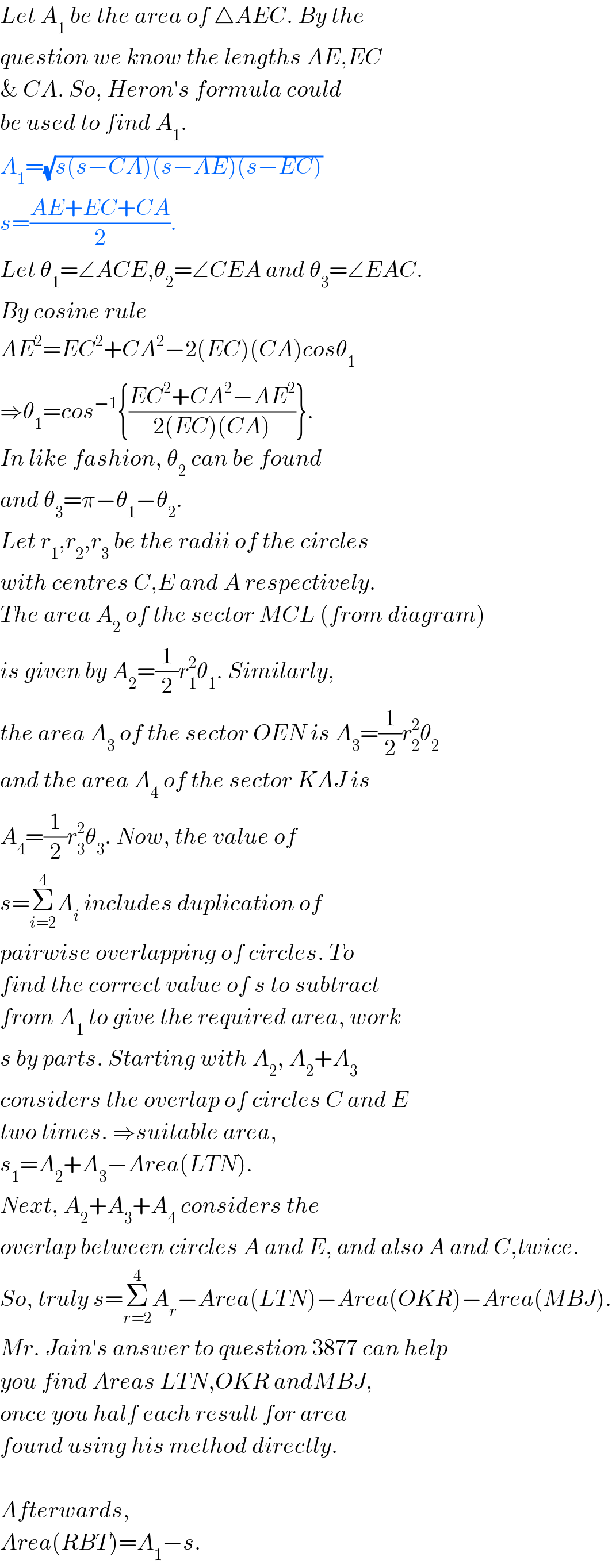
Question Number 4036 by Rasheed Soomro last updated on 27/Dec/15

$$\mathrm{Twin}\:\mathrm{of}\:\mathrm{Q}#\mathrm{3943} \\ $$$$\mathrm{Three}\:\mathrm{circles}\:\mathrm{are}\:\mathrm{drawn}\:\mathrm{in}\:\mathrm{a}\:\mathrm{plane} \\ $$$$\mathrm{in}\:\mathrm{such}\:\mathrm{a}\:\mathrm{way}\:\mathrm{that}\:\mathrm{a}\:\mathrm{closed}\:\mathrm{region} \\ $$$$\mathrm{is}\:\mathrm{produced}\:\mathrm{which}\:\mathrm{is}\:\mathrm{not}\:\mathrm{included} \\ $$$$\mathrm{in}\:\mathrm{any}\:\mathrm{of}\:\mathrm{the}\:\mathrm{circles}.\:\mathrm{Determine}\:\mathrm{the} \\ $$$$\mathrm{area}\:\mathrm{of}\:\mathrm{this}\:\mathrm{region}. \\ $$$$\underset{−} {\mathrm{Circles}\:\mid\:\mathrm{Radii}\:\mid\:\mathrm{Centers}\:} \\ $$$$\:\:\:\:\:\:\mathrm{A}\:\:\:\:\:\:\:\:\:\:\:\:\:\:\:\boldsymbol{\mathrm{r}}_{\mathrm{1}} \:\:\:\:\:\:\:\:\:\:\:\:\:\mathrm{C}_{\mathrm{1}} \:\:\:\:\:\: \\ $$$$\:\:\:\:\:\:\:\mathrm{B}\:\:\:\:\:\:\:\:\:\:\:\:\:\:\boldsymbol{\mathrm{r}}_{\mathrm{2}} \:\:\:\:\:\:\:\:\:\:\:\:\:\mathrm{C}_{\mathrm{2}} \\ $$$$\:\:\:\:\:\:\:\mathrm{C}\:\:\:\:\:\:\:\:\:\:\:\:\:\:\boldsymbol{\mathrm{r}}_{\mathrm{3}} \:\:\:\:\:\:\:\:\:\:\:\:\:\:\mathrm{C}_{\mathrm{3}} \\ $$$$\mathrm{Conditions}: \\ $$$$\:\:\:\:\:\boldsymbol{\mathrm{r}}_{\mathrm{1}} +\boldsymbol{\mathrm{r}}_{\mathrm{2}} \geqslant\mathrm{C}_{\mathrm{1}} \mathrm{C}_{\mathrm{2}} \\ $$$$\:\:\:\:\:\boldsymbol{\mathrm{r}}_{\mathrm{2}} +\boldsymbol{\mathrm{r}}_{\mathrm{3}} \geqslant\mathrm{C}_{\mathrm{2}} \mathrm{C}_{\mathrm{3}} \\ $$$$\:\:\:\:\:\boldsymbol{\mathrm{r}}_{\mathrm{3}} +\boldsymbol{\mathrm{r}}_{\mathrm{1}} \geqslant\mathrm{C}_{\mathrm{3}} \mathrm{C}_{\mathrm{1}} \\ $$
Commented by Yozzii last updated on 27/Dec/15

Commented by Yozzii last updated on 27/Dec/15

$${Area}\:{of}\:{region}\:{GHI}\:{is}\:{required}. \\ $$
Commented by Rasheed Soomro last updated on 27/Dec/15

$$\mathrm{Yes}.\:\mathrm{Exactly}! \\ $$$$\mathrm{In}\:\mathrm{other}\:\mathrm{cases}\:\mathrm{two}\:\mathrm{or}\:\:\mathrm{all}\:\mathrm{the}\:\mathrm{three} \\ $$$$\mathrm{circles}\:\mathrm{are}\:\mathrm{tangent}\:\mathrm{to}\:\mathrm{one}\:\mathrm{another}. \\ $$
Commented by Yozzii last updated on 27/Dec/15

Commented by Yozzii last updated on 27/Dec/15

$${Disregard}\:{the}\:{explicit}\:{measurements} \\ $$$${of}\:{angles}\:{given}\:{in}\:{the}\:{diagram}.\: \\ $$$${I}\:{only}\:{required}\:{the}\:{image}\:{to}\:{delineate} \\ $$$${the}\:{important}\:{angles}\:{for}\:{the}\:{calculation}. \\ $$
Commented by Yozzii last updated on 27/Dec/15

$${Let}\:{A}_{\mathrm{1}} \:{be}\:{the}\:{area}\:{of}\:\bigtriangleup{AEC}.\:{By}\:{the} \\ $$$${question}\:{we}\:{know}\:{the}\:{lengths}\:{AE},{EC} \\ $$$$\&\:{CA}.\:{So},\:{Heron}'{s}\:{formula}\:{could} \\ $$$${be}\:{used}\:{to}\:{find}\:{A}_{\mathrm{1}} .\: \\ $$$${A}_{\mathrm{1}} =\sqrt{{s}\left({s}−{CA}\right)\left({s}−{AE}\right)\left({s}−{EC}\right)} \\ $$$${s}=\frac{{AE}+{EC}+{CA}}{\mathrm{2}}. \\ $$$${Let}\:\theta_{\mathrm{1}} =\angle{ACE},\theta_{\mathrm{2}} =\angle{CEA}\:{and}\:\theta_{\mathrm{3}} =\angle{EAC}. \\ $$$${By}\:{cosine}\:{rule}\: \\ $$$${AE}^{\mathrm{2}} ={EC}^{\mathrm{2}} +{CA}^{\mathrm{2}} −\mathrm{2}\left({EC}\right)\left({CA}\right){cos}\theta_{\mathrm{1}} \\ $$$$\Rightarrow\theta_{\mathrm{1}} ={cos}^{−\mathrm{1}} \left\{\frac{{EC}^{\mathrm{2}} +{CA}^{\mathrm{2}} −{AE}^{\mathrm{2}} }{\mathrm{2}\left({EC}\right)\left({CA}\right)}\right\}. \\ $$$${In}\:{like}\:{fashion},\:\theta_{\mathrm{2}} \:{can}\:{be}\:{found} \\ $$$${and}\:\theta_{\mathrm{3}} =\pi−\theta_{\mathrm{1}} −\theta_{\mathrm{2}} . \\ $$$${Let}\:{r}_{\mathrm{1}} ,{r}_{\mathrm{2}} ,{r}_{\mathrm{3}} \:{be}\:{the}\:{radii}\:{of}\:{the}\:{circles} \\ $$$${with}\:{centres}\:{C},{E}\:{and}\:{A}\:{respectively}. \\ $$$${The}\:{area}\:{A}_{\mathrm{2}} \:{of}\:{the}\:{sector}\:{MCL}\:\left({from}\:{diagram}\right) \\ $$$${is}\:{given}\:{by}\:{A}_{\mathrm{2}} =\frac{\mathrm{1}}{\mathrm{2}}{r}_{\mathrm{1}} ^{\mathrm{2}} \theta_{\mathrm{1}} .\:{Similarly}, \\ $$$${the}\:{area}\:{A}_{\mathrm{3}} \:{of}\:{the}\:{sector}\:{OEN}\:{is}\:{A}_{\mathrm{3}} =\frac{\mathrm{1}}{\mathrm{2}}{r}_{\mathrm{2}} ^{\mathrm{2}} \theta_{\mathrm{2}} \\ $$$${and}\:{the}\:{area}\:{A}_{\mathrm{4}} \:{of}\:{the}\:{sector}\:{KAJ}\:{is} \\ $$$${A}_{\mathrm{4}} =\frac{\mathrm{1}}{\mathrm{2}}{r}_{\mathrm{3}} ^{\mathrm{2}} \theta_{\mathrm{3}} .\:{Now},\:{the}\:{value}\:{of}\: \\ $$$${s}=\underset{{i}=\mathrm{2}} {\overset{\mathrm{4}} {\sum}}{A}_{{i}} \:{includes}\:{duplication}\:{of}\: \\ $$$${pairwise}\:{overlapping}\:{of}\:{circles}.\:{To} \\ $$$${find}\:{the}\:{correct}\:{value}\:{of}\:{s}\:{to}\:{subtract} \\ $$$${from}\:{A}_{\mathrm{1}} \:{to}\:{give}\:{the}\:{required}\:{area},\:{work} \\ $$$${s}\:{by}\:{parts}.\:{Starting}\:{with}\:{A}_{\mathrm{2}} ,\:{A}_{\mathrm{2}} +{A}_{\mathrm{3}} \\ $$$${considers}\:{the}\:{overlap}\:{of}\:{circles}\:{C}\:{and}\:{E} \\ $$$${two}\:{times}.\:\Rightarrow{suitable}\:{area}, \\ $$$${s}_{\mathrm{1}} ={A}_{\mathrm{2}} +{A}_{\mathrm{3}} −{Area}\left({LTN}\right). \\ $$$${Next},\:{A}_{\mathrm{2}} +{A}_{\mathrm{3}} +{A}_{\mathrm{4}} \:{considers}\:{the}\: \\ $$$${overlap}\:{between}\:{circles}\:{A}\:{and}\:{E},\:{and}\:{also}\:{A}\:{and}\:{C},{twice}. \\ $$$${So},\:{truly}\:{s}=\underset{{r}=\mathrm{2}} {\overset{\mathrm{4}} {\sum}}{A}_{{r}} −{Area}\left({LTN}\right)−{Area}\left({OKR}\right)−{Area}\left({MBJ}\right). \\ $$$${Mr}.\:{Jain}'{s}\:{answer}\:{to}\:{question}\:\mathrm{3877}\:{can}\:{help} \\ $$$${you}\:{find}\:{Areas}\:{LTN},{OKR}\:{andMBJ}, \\ $$$${once}\:{you}\:{half}\:{each}\:{result}\:{for}\:{area}\: \\ $$$${found}\:{using}\:{his}\:{method}\:{directly}. \\ $$$$ \\ $$$${Afterwards},\: \\ $$$${Area}\left({RBT}\right)={A}_{\mathrm{1}} −{s}. \\ $$
Commented by Rasheed Soomro last updated on 27/Dec/15

$$\:\:\:\:\:\:\:\:\:\:\:\:\:\:\:\:\:\:\:\:\:\:\:\:\:\:\:\:\:\:\:\:\:\:\:\:\:\:\:\:\:\:\:\:\:\:\:\:\:\:\:\:\:\mathbb{G}\mathcal{REA}\mathbb{T}\:! \\ $$$$\:\:\:\:\:\:\:\:\:\:\:\:\:\:\:\:\:\:\:\:\mathbb{Y}\mathcal{OU}\:\:\:\mathbb{H}\mathcal{AVE}\:\mathbb{D}\mathcal{ONE}\:\:\mathbb{S}\mathcal{UCCESSFULLY}! \\ $$
